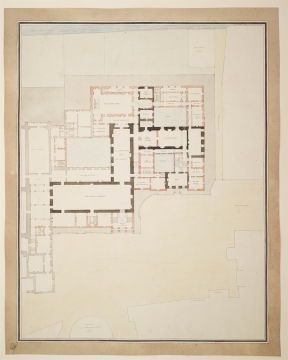
Browse
Reference number
Purpose
Aspect
27 Plan of ground floor
Scale
Inscribed
(27) labelled: Mr Delavals / House, Parliament Stairs, Abingdon Street, Mr Wilberforce, Mr Wharton, Mr Cowper, Mr Rose, Part of / King Henry the Seventh's / Chapel, rooms labelled: Part of Westminster Hall, Lobby, House of Commons, Entrance / for / His Majesty, The Court of Requests, The Long Gallery, The Painted Chamber / and / for Conferences, The Lord / Great Chancellor, Hall, The Earl Marshall, Privy Seal, Lord Chancellor, Court, His Majesty's / Robing Room, Lobby / for the / Witnesses, Committee Room, Serjeant at Arms / to / Attend the House, Black Rod, Assistant Clerk / of / Parliament, The House of Lords, Portico (twice), Clerk of Parliament, Bishops / and / Archbishops, Princes Chamber together with passages, doorkeepers, lobbies, ante-rooms, staircases and water closets
Signed and dated
- (26) see Notes below
Medium and dimensions
Hand
Notes
Drawing 26, as with drawing 27, places the new House of Commons in the north-east corner of the site and here it lies longitudinally having the throne at the eastern end. Internally the chamber has a cruciform plan with apsidal arms, one of which leads via a lobby to the King's Robing Room. The royal progress has the same portico, staircase hall and route through the Court of Requests and Painted Chamber as drawing 27 but on reaching the lobby of the House of Lords takes a right turn along a passage and another lobby to the Robing Room on the south-east corner.
Drawing 27 places the new House of Lords in the north-east corner of the site so that it lies laterally (north/south) with a blind portico on its eastern flank containing a water closet reached by a side entrance. The King's Entrance on the west side has a portico with three openings and the royal route is through a hall with a double staircase through the Court of Requests and the Painted Chamber with a left-turn into the King's Robing Room that gives directly on to the throne of the House of Lords.
S. Sawyer, 'Soane at Westminster'. PhD thesis, Columbia University, 1999, p. 168, puts drawings 26 and 27 (together with 29) as scheme 'A3' in Soane's sequence of designs for the House of Lords. Elevations 54-56 and 61 relate to this scheme.
Level
Sir John Soane's collection includes some 30,000 architectural, design and topographical drawings which is a very important resource for scholars worldwide. His was the first architect’s collection to attempt to preserve the best in design for the architectural profession in the future, and it did so by assembling as exemplars surviving drawings by great Renaissance masters and by the leading architects in Britain in the 17th and 18th centuries and his near contemporaries such as Sir William Chambers, Robert Adam and George Dance the Younger. These drawings sit side by side with 9,000 drawings in Soane’s own hand or those of the pupils in his office, covering his early work as a student, his time in Italy and the drawings produced in the course of his architectural practice from 1780 until the 1830s.
Browse (via the vertical menu to the left) and search results for Drawings include a mixture of Concise catalogue records – drawn from an outline list of the collection – and fuller records where drawings have been catalogued in more detail (an ongoing process).




